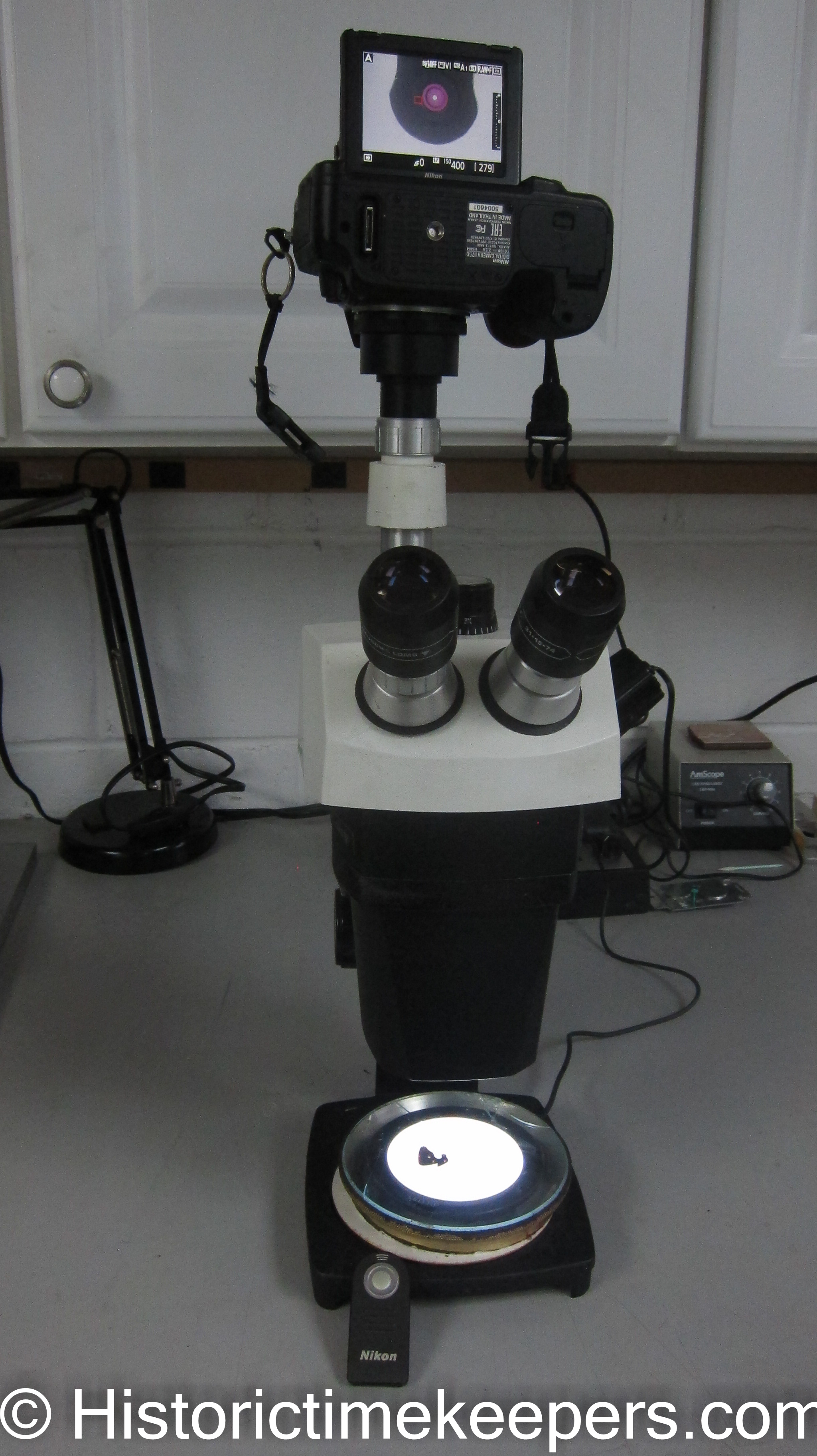Popular Highlights
When only a watchmaker will do
Restoration of Omega Jump Seconds Clock
| Microscopes in Watchmaking |
 |

(Left: Locating .8mm carbide drill to drill broken screw from stem using the Sherline mill)
(Below:Microscope view of the .8mm carbide
drill setup) 

(Above: View of a balance pivot at 25X makes things obvious)
I first tried microscopes in the 1990s when the Russian imports came along. They were around $300, while lab grade scopes were over $1000. After a year or two I just put it aside and then sold it.
Now I know why. Good stereoscopic microscopes have become indispensable to me. I have a Nikon SMZ 1B with a .5X reducer lens at the bench for assembly and lubrication. This gives me a magnification range of 7X to 25X. I have a Reichert 570 (American Optical/AO) 7X to 42X on a boom for all hand turning and setting up the Sherline mill. I use a fixed focus Olympus over my 102 lathe.
Then I have a Bausch and Lomb StereoZoom 7 (10X to 70X) for close inspection and taking photos for customers (Very easy with a tilt screen camera like a Nikon D750). If you have a tilt screen camera, today you can take very high quality microphotographs that were beyond the reach of most individuals only 20 years ago and with much less setup. I happen to have a scope with a dedicated camera port, but you can use an eyepiece tube just as easily with the same results.

Above: Documenting jewel holes with Bausch microscope and Nikon tilt screen camera. Note use of wireless shutter release.
While 4 scopes may seem like overkill, having these setups allows me to move freely from one station to another without moving heavy bases and light sources. Like some people have multiple small machine setups based on WW lathes so they do not have to tear down in order to do the various jobs.


(Above: View of turning through microscope)
(Left: Using microscope for dead center turning)
Any one of these scopes cost what the low quality scope cost that I purchased in 1995. And with inflation, they actually cost less.
The reason I was dissatisfied was because the lower quality scope I used years ago was not well made or aligned. A stereoscopic zoom scope should remain in focus throughout its zoom range and the object should stay centered. The optics for each eye must be offset enough for true 3D vision; but if the offset is too different will cause fatigue.


Properly oiled balance hole jewel Checking pallet jewel condition


(Detail of oiling escapement under two magnifications)

(Above: View of properly oiled escapement: note layer between jewel and tooth; also no oil on top of teeth or jewels)
In recent years institutions have moved to digital imaging for microscopic work. This has freed institution-grade instruments in great shape for other uses. These scopes are generally well cared for and if you stick with Nikon the SMZ 1, 1B or SMZ-2B, the Bausch and Lombs (now Leica) and American Optical (Reichert) they are extremely robust and easy to maintain.
The microscopes made by these three makers were the mainstay of quality assurance departments in electronics and manufacturing, as well as in biology departments for dissection and botany. While they are "old school", the fact is that 20 years ago they were top of the line equipment.
As a service to other watchmakers (seriously), I buy good ex-institution grade microscopes for resale watch repairers and those who do brand recognized after sales service. They can be found on my Watchmaker Microscopes for Sale page.
About the only major mechanical issue is that the zoom mechanisms were lubricated with something called Plastilube, which turns to glue. It cleans off easily enough with IPA and then relube with MolyKote.
I do not disassemble the optics or touch them with a solvent. The units I use are well sealed and film on the internal optics has been a non-issue. I do hit them with air before recasing, but that is it.
I am now 63 and had cataracts removed in both eyes. It was while I was waiting that I rediscovered microscopes. I was losing edges and pretending I could see. Now with the cataracts gone, I have found the main issue in my dominant (loupe) eye was "floaters", debris in the eyeball that causes shadows. Many times it is like looking through a tangle of fishing line for me.
Never occurred to me to switch eyes and the ophthalmologist cannot see your floaters to tell you what is going on. Using the microscopes enables me to form a good image using the information from both eyes rather than the degraded image provided by the use of a single loupe.
The other advantages I have observed are posture and the very significant advantage of not having your nose in the way or your head moving around while using a 10X loupe. I work routinely at 20X at the bench with complete control and have a good 6 inches of clearance under the microscope.
As far as I am concerned, a watchmaker has not lived until he/she has perfectly oiled an escapement in an Omega 682 using a good stereoscopic microscope.
